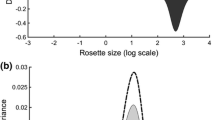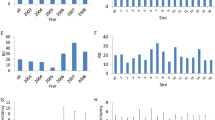Abstract
Individuals respond to different environments by developing different phenotypes, which is generally seen as a mechanism through which individuals can buffer adverse environmental conditions and increase their fitness. To understand the consequences of phenotypic plasticity it is necessary to study how changing a particular trait of an individual affects either its survival, growth, reproduction or a combination of these demographic vital rates (i.e. fitness components). Integrating vital rate changes due to phenotypic plasticity into models of population dynamics allows detailed study of how phenotypic changes scale up to higher levels of integration and forms an excellent tool to distinguish those plastic trait changes that really matter at the population level. A modeling approach also facilitates studying systems that are even more complex: traits and vital rates often co-vary or trade-off with other traits that may show plastic responses over environmental gradients. Here we review recent developments in the literature on population models that attempt to include phenotypic plasticity with a range of evolutionary assumptions and modeling techniques. We present in detail a model framework in which environmental impacts on population dynamics can be followed analytically through direct and indirect pathways that importantly incorporate phenotypic plasticity, trait-trait and trait-vital rate relationships. We illustrate this framework with two case studies: the population-level consequences of phenotypic responses to nutrient enrichment of plant species occurring in nutrient-poor habitats and of responses to changes in flooding regimes due to climate change. We conclude with exciting prospects for further development of this framework: selection analyses, modeling advances and the inclusion of spatial dynamics by considering dispersal traits as well.



Similar content being viewed by others
References
Agrawal AA (2001) Phenotypic plasticity in the interactions and evolution of species. Science 294:321–326
Bakker VJ, Doak DF, Roemer GW, Garcelon DK, Coonan TJ, Morrison SA, Lynch C, Ralls K, Shaw R (2009) Incorporating ecological drivers and uncertainty into a demographic population viability analysis for the island fox. Ecol Monogr 79:77–108
Blom CWPM, Voesenek LACJ (1996) Flooding: the survival strategies of plants. Trends Ecol Evol 11:290–295
Boedeltje G, Bakker JP, ten Brinke A, van Groenendael JM, Soesbergen M (2004) Dispersal phenology of hydrochorous plants in relation to discharge, seed release time and buoyancy of seeds: the flood pulse concept supported. J Ecol 92:786–796
Boyce MS, Haridas CV, Lee CT, NCEAS Stochastic Demography Working Group (2006) Demography in an increasingly variable world. Trends Ecol Evol 21:141–148
Bradshaw AD (2006) Unravelling phenotypic plasticity—why should we bother? New Phytol 170:644–648
Callaway RM, Pennings SC, Richards CL (2003) Phenotypic plasticity and interactions among plants. Ecology 84:1115–1128
Caswell H (1983) Phenotypic plasticity in life-history traits: demographic effects and evolutionary consequences. Am Zool 23:35–46
Caswell H (2001) Matrix population models. Construction, analysis, and interpretation. Sinauer. Sunderland, MA, US
Coulson T, Tuljapurkar S (2008) The dynamics of a quantitative trait in an age-structured population living in a variable environment. Am Nat 172:599–612
Coulson T, Kruuk LEB, Tavecchia G, Pemberton JM, Clutton-Brock TH (2003) Estimating selection on neonatal traits in red deer using elasticity path analysis. Evolution 57:2879–2892
Coulson T, Benton TG, Lundberg P, Dall SRX, Kendall BE, Gaillard JM (2006) Estimating individual contributions to population growth: evolutionary fitness in ecological time. Proc R Soc B 273:547–555
de Kroon H, van Groenendael JM, Ehrlén J (2000) Elasticities: a review of methods and model limitations. Ecology 81:607–618
de Vere N, Jongejans E, Plowman A, Williams E (2009) Population size and habitat quality affect genetic diversity and fitness in the clonal herb Cirsium dissectum. Oecologia 159:59–68
Easterling MR, Ellner SP, Dixon PM (2000) Size-specific sensitivity: applying a new structured population model. Ecology 81:694–708
Ehrlén J (2003) Fitness components versus total demographic effects: evaluating herbivore impacts on a perennial herb. Am Nat 162:796–810
Elderd BD, Doak DF (2006) Comparing the direct and community-mediated effects of disturbance on plant population dynamics: flooding, herbivory and Mimulus guttatus. J Ecol 94:656–669
Ellner SP, Rees M (2006) Integral projection models for species with complex demography. Am Nat 167:410–428
Fox GA, Kendall BE (2002) Demographic stochasticity and the variance reduction effect. Ecology 83:1928–1934
Franco M, Silvertown J (2004) A comparative demography of plants based upon elasticities of vital rates. Ecology 85:531–538
Horvitz C, Schemske DW, Caswell H (1997) The relative “importance” of life-history stages to population growth: prospective and retrospective analyses. In: Tuljapurkar S, Caswell H (eds) Structured-population models in marine, terrestrial, and freshwater systems. Chapman & Hall, New York
Huber H, Kane NC, Heschel MS, von Wettberg EJ, Banta J, Leuck AM, Schmitt J (2004) Frequency and microenvironmental pattern of selection on plastic shade-avoidance traits in a natural population of Impatiens capensis. Am Nat 163:548–563
Huber H, Jacobs E, Visser EJW (2009) Variation in flooding-induced morphological traits in natural populations of white clover (Trifolium repens) and their effects on plant performance during soil flooding. Ann Bot 103:377–386
Hutchings MJ, de Kroon H (1994) Foraging in plants: the role of morphological plasticity in resource acquisition. Adv Ecol Res 25:159–238
Jongejans E, de Kroon H (2005) Space versus time variation in the population dynamics of three co-occurring perennial herbs. J Ecol 93:681–692
Jongejans E, de Kroon H, Berendse F (2006) The interplay between shifts in biomass allocation and costs of reproduction in four grassland perennials under simulated successional change. Oecologia 147:369–378
Jongejans E, de Vere N, de Kroon H (2008) Demographic vulnerability of the clonal and endangered meadow thistle. Plant Ecol 198:225–240
Knight TM, Barfield M, Holt RD (2008) Evolutionary dynamics as a component of stage-structured matrix models: an example using Trillium grandiflorum. Am Nat 172:375–392
Koons DN, Pavard S, Baudisch A, Metcalf CJE (2009) Is life-history buffering or lability adaptive in stochastic environments? Oikos 118:972–980
Kurashige NS, Callahan HS (2007) Evolution of active and passive forms of plasticity: insights from artificially selected Arabidopsis. Evol Ecol Res 9:935–945
Lenssen JPM, de Kroon H (2005) Abiotic constraints at the upper boundaries of two Rumex species on a freshwater flooding gradient. J Ecol 93:138–147
Metcalf CJE, Mitchell-Olds T (2009) Life history in a model system: opening the black box with Arabidopsis thaliana. Ecol Lett 12:593–600
Metcalf CJE, Pavard S (2007) Why evolutionary biologists should be demographers. Trends Ecol Evol 22:205–212
Miner BG, Sultan SE, Morgan SG, Padilla DK, Relyea RA (2005) Ecological consequences of phenotypic plasticity. Trends Ecol Evol 20:685–692
Mommer L, Lenssen JPM, Huber H, Visser EJW, de Kroon H (2006) Ecophysiological determinants of plant performance under flooding: a comparative study of seven plant families. J Ecol 94:1117–1129
Morris WF, Doak DF (2004) Buffering of life histories against environmental stochasticity: accounting for a spurious correlation between the variabilities of vital rates and their contributions to fitness. Am Nat 163:579–590
Nathan R (2007) Total dispersal kernels and the evaluation of diversity and similarity in complex dispersal systems. In: Dennis AJ, Schupp EW, Green RJ, Westcott DA (eds) Seed dispersal theory and its application in a changing world. CABI, Wallingford
Neitzke M (2001) Analysis of vegetation and nutrient supply in calcareous grassland border zones to determine critical loads for nitrogen. Flora 196:292–303
Neubert MG, Caswell H (2000) Demography and dispersal: calculation and sensitivity analysis of invasion speed for structured populations. Ecology 81:1613–1628
Pelletier F, Clutton-Brock T, Pemberton J, Tuljapurkar S, Coulson T (2007) The evolutionary demography of ecological change: linking trait variation and population growth. Science 315:1571–1574
Pfister CA (1998) Patterns of variance in stage-structured populations: evolutionary predictions and ecological implications. Proc Natl Acad Sci USA 95:213–218
Picotte JJ, Rosenthal DM, Rhode JM, Cruzan MB (2007) Plastic responses to temporal variation in moisture availability: consequences for water use efficiency and plant performance. Oecologia 153:821–832
Pierik R, van Aken JM, Voesenek LACJ (2009) Is elongation-induced leaf emergence beneficial for submerged Rumex species? Ann Bot 103:353–357
Pigliucci M (2001) Phenotypic plasticity: beyond nature and nurture. Johns Hopkins University Press, Baltimore
Pigliucci M, Kolodynska A (2006) Phenotypic integration and response to stress in Arabidopsis thaliana: a path analytical approach. Evol Ecol Res 8:415–433
Rees M, Rose KE (2002) Evolution of flowering strategies in Oenothera glazioviana: an integral projection model approach. Proc R Soc Lond Ser B-Biol Sci 269:1509–1515
Smith M, Caswell H, Mettler-Cherry P (2005) Stochastic flood and precipitation regimes and the population dynamics of a threatened floodplain plant. Ecol Appl 15:1036–1052
Soons MB, Messelink JH, Jongejans E, Heil GW (2005) Habitat fragmentation reduces grassland connectivity for both short-distance and long-distance wind-dispersed forbs. J Ecol 93:1214–1225
Stevens CJ, Dise NB, Mountford JO, Gowing DJ (2004) Impact of nitrogen deposition on the species richness of grasslands. Science 303:1876–1879
Sultan SE (1995) Phenotypic plasticity and plant adaptation. Acta Bot Neerl 44:363–383
Sultan SE (2007) Development in context: the timely emergence of eco-devo. Trends Ecol Evol 22:575–582
Sultan SE, Stearns SC (2005) Environmentally contingent variation: phenotypic plasticity and norms of reaction. In: Hallgrímsson B, Hall BK (eds) Variation: a hierarchical examination of a central concept in biology. Elsevier Academic Press, Amsterdam
Tonsor SJ, Scheiner SM (2007) Plastic trait integration across a CO2 gradient in Arabidopsis thaliana. Am Nat 169:E119–E140
Tuljapurkar S (1990) Population dynamics in variable environments. Springer, New York
Tuljapurkar S, Horvitz CC, Pascarella JB (2003) The many growth rates and elasticities of populations in random environments. Am Nat 162:489–502
van der Sman AJM, Joosten NN, Blom CWPM (1993) Flooding regimes and life-history characteristics of short-lived species in river forelands. J Ecol 81:121–130
van Eck WHJM, van de Steeg HM, Blom CWPM, de Kroon H (2004) Is tolerance to summer flooding correlated with distribution patterns in river floodplains? a comparative study of 20 terrestrial grassland species. Oikos 107:393–405
van Eck WHJM, Lenssen JPM, van de Steeg HM, Blom CWPM, de Kroon H (2006) Seasonal dependent effects of flooding on plant species survival and zonation: a comparative study of 10 terrestrial grassland species. Hydrobiologia 565:59–69
van Kleunen M, Fischer M (2005) Constraints on the evolution of adaptive phenotypic plasticity in plants. New Phytol 166:49–60
van Kleunen M, Fischer M (2007) Progress in the detection of costs of phenotypic plasticity in plants. New Phytol 176:727–730
van Splunder I, Coops H, Voesenek LAC, Blom CWPM (1995) Establishment of alluvial forest species in floodplains: the role of dispersal timing, germination characteristics and water level fluctuations. Acta Bot Neerl 44:269–278
van Tienderen PH (2000) Elasticities and the link between demographic and evolutionary dynamics. Ecology 81:666–679
Verschoor AM, Vos M, van der Stap I (2004) Inducible defences prevent strong population fluctuations in bi- and tritrophic food chains. Ecol Lett 7:1143–1148
Visser EJW, Bögemann GM, van de Steeg HM, Pierik R, Blom CWPM (2000) Flooding tolerance of Carex species in relation to field distribution and aerenchyma formation. New Phytol 148:93–103
Voesenek LACJ, Rijnders JHGM, Peeters AJM, van de Steeg HMV, de Kroon H (2004) Plant hormones regulate fast shoot elongation under water: from genes to communities. Ecology 85:16–27
Weijschedé J, Martínková J, de Kroon H, Huber H (2006) Shade avoidance in Trifolium repens: costs and benefits of plasticity in petiole length and leaf size. New Phytol 172:655–666
Acknowledgments
We are grateful to Eric Visser, Linda Jorritsma-Wienk, Pieter Zuidema, Juul Limpens, Gerard Bögemann and Annemiek Smit-Tiekstra for helpful discussions. Staatsbosbeheer kindly gave permission to perform the demography study in their nature reserve. This research was funded by the Netherlands Organisation for Scientific Research (NWO-grant 80.33.452 to HdK and NWO-veni-grant 863.08.006 to EJ).
Author information
Authors and Affiliations
Corresponding author
Electronic supplementary material
Below is the link to the electronic supplementary material.
Rights and permissions
About this article
Cite this article
Jongejans, E., Huber, H. & de Kroon, H. Scaling up phenotypic plasticity with hierarchical population models. Evol Ecol 24, 585–599 (2010). https://doi.org/10.1007/s10682-009-9340-2
Received:
Accepted:
Published:
Issue Date:
DOI: https://doi.org/10.1007/s10682-009-9340-2




